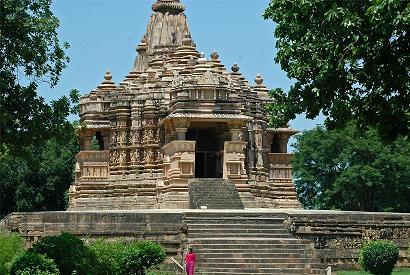|
Khajuraho
is a charming village with a picturesque rural ambience and a rich
cultural heritage. Khajuraho is located in the state of Madhya
Pradesh, the heart of Central India. Khajuraho was the capital of the
Chandela dynasty. The Chandela Kings claimed descent from the moon.
Khajuraho or 'Khajur-vahika' (bearer of date palms), also known as 'Khajjurpura'
in ancient times derives its name from the golden date palms (khajur)
that decorated its city gates. All over the world Khajuraho is famous
due to its temples. Temples of Khajuraho are the finest examples of
temple craftsmanship in the whole of India. After Agra the most
frequently visited place in India is Khajuraho. The maximum
temperature in Khajuraho is around 47 degree Celsius and in winters it
is around 4 degree Celsius minimum. The common languages spoken in
Khajuraho are English and Hindi. Best time to visit Khajuraho is from
October to March. |

Chitragupta Temple |
|
Khajuraho
was the cultural capital of Chandel Rajputs, a Hindu dynasty that
ruled Khajuraho from the 10 to 12th centuries. Chandel Kings never
lived in their cultural capital because of this Khajuraho has no
forts. Chandela Kings claimed descent from the Chandra, the moon god.
Hemvati, the beautiful daughter of a Brahmin priest of Varanasi was
seduced by the Moon God while she was bathing according to a legend.
The child born of this union was a son, Chandravarman. The unwed
mother took refuge in the forest as condemned by society. The boy grew
up to found the Chandela dynasty. He dreamt that his mother wanted him
to build temples to reveal human passions. Chandravarman began the
foundation of the temples and successive rulers added to the complex.
After the decline of Chandela dynasty's decline in the 13th century,
the temples were concealed by dense jungles. In 1838 a British army
engineer, Captain T.S. Burt rediscovered Khajuraho. Khajuraho was
opened to tourists only a few decades ago. |
|
Prominent
tourist attraction in Khajuraho are the Khajuraho temples which are
India's unique gift to the world. Khajuraho temples are the finest
examples of temple craftsmanship in India. These temples are a
collective salute to creativity, joy and life. Erotic sculptures in
the temples of Khajuraho display different aspects of Hinduism. The
temples are divided into three geographical groups namely, Western,
Eastern and Southern. Various temples like Chaunsat Yogini Temple,
Varaha Temple, Vishwanath Temple, Chitragupta Temple, Matangeswara
Temple, Kandariya Mahadeo Temple, Devi Jagdambe Temple, Nandi Temple,
Lakshmana Temple etc are in the Western Group. In the eastern group
there are Hindu and Jain temples which are close to Khajuraho village.
The largest Jain temple, Parsvanath, belong to this group. Other
temples are Adinath Temple, Ghantai Temple, Brahma, Javari and Vamana
temples. Southern group is about 5 kms away from Khajuraho village.
Duladeo Temple and Chaturbhuj Temple belong to Southern group of
temples.
|
|
By
Rail:
Jhansi is the nearest railway station on the main Delhi to Mumbai
railway line from Khajuraho. There is no direct route that links
Varanasi to Khajuraho. Satna is the nearest station which is about 4
hours from Khajuraho.
By
Road:
Khajuraho is linked by road to the various parts of India. There are
regular bus services from Gwalior, Jhansi and Agra.
By Air:
Khajuraho is linked with various cities of India. Khajuraho airport
is about 5 kms from the village centre. Indian Airlines daily operate
flight from Delhi to Khajuraho via Agra. |